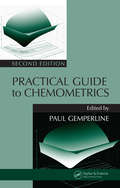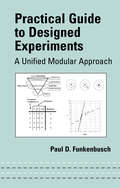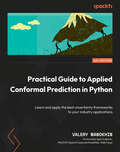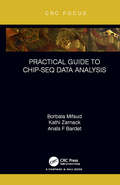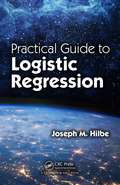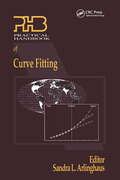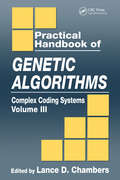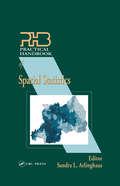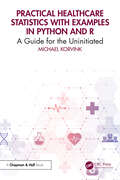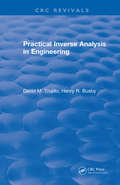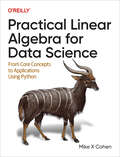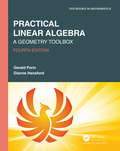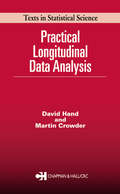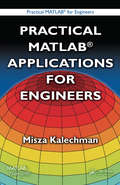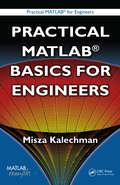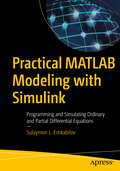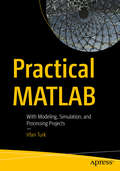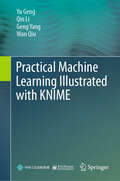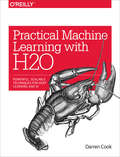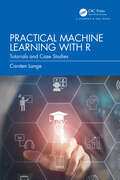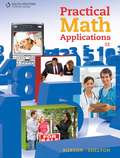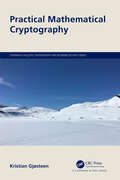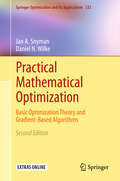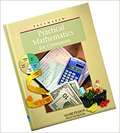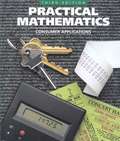- Table View
- List View
Practical Guide To Chemometrics
by Paul GemperlineThe limited coverage of data analysis and statistics offered in most undergraduate and graduate analytical chemistry courses is usually focused on practical aspects of univariate methods. Drawing in real-world examples, Practical Guide to Chemometrics, Second Edition offers an accessible introduction to application-oriented multivariate meth
Practical Guide To Designed Experiments: A Unified Modular Approach (Mechanical Engineering)
by Paul D. FunkenbuschMany engineers and scientists have receive little or no training in designed experiments, and any courses that are available tend to be either abstract and divorced from practical considerations or strictly practical-lacking the rigor and depth necessary for true, long-term understanding.Practical Guide to Designed Experiments: A Unified Mo
Practical Guide to Applied Conformal Prediction in Python: Learn and apply the best uncertainty frameworks to your industry applications
by Valery ManokhinElevate your machine learning skills using the Conformal Prediction framework for uncertainty quantification. Dive into unique strategies, overcome real-world challenges, and become confident and precise with forecasting.Key FeaturesMaster Conformal Prediction, a fast-growing ML framework, with Python applicationsExplore cutting-edge methods to measure and manage uncertainty in industry applicationsUnderstand how Conformal Prediction differs from traditional machine learningBook DescriptionIn the rapidly evolving landscape of machine learning, the ability to accurately quantify uncertainty is pivotal. The book addresses this need by offering an in-depth exploration of Conformal Prediction, a cutting-edge framework to manage uncertainty in various ML applications. Learn how Conformal Prediction excels in calibrating classification models, produces well-calibrated prediction intervals for regression, and resolves challenges in time series forecasting and imbalanced data. Discover specialised applications of conformal prediction in cutting-edge domains like computer vision and NLP. Each chapter delves into specific aspects, offering hands-on insights and best practices for enhancing prediction reliability. The book concludes with a focus on multi-class classification nuances, providing expert-level proficiency to seamlessly integrate Conformal Prediction into diverse industries. With practical examples in Python using real-world datasets, expert insights, and open-source library applications, you will gain a solid understanding of this modern framework for uncertainty quantification. By the end of this book, you will be able to master Conformal Prediction in Python with a blend of theory and practical application, enabling you to confidently apply this powerful framework to quantify uncertainty in diverse fields.What you will learnThe fundamental concepts and principles of conformal predictionLearn how conformal prediction differs from traditional ML methodsApply real-world examples to your own industry applicationsExplore advanced topics - imbalanced data and multi-class CPDive into the details of the conformal prediction frameworkBoost your career as a data scientist, ML engineer, or researcherLearn to apply conformal prediction to forecasting and NLPWho this book is forIdeal for readers with a basic understanding of machine learning concepts and Python programming, this book caters to data scientists, ML engineers, academics, and anyone keen on advancing their skills in uncertainty quantification in ML.
Practical Guide to ChIP-seq Data Analysis (Focus Computational Biology Series)
by Borbala Mifsud Kathi Zarnack Anaïs F BardetChromatin immunoprecipitation sequencing (ChIP-seq), which maps the genome-wide localization patterns of transcription factors and epigenetic marks, is among the most widely used methods in molecular biology. Practical Guide to ChIP-seq Data Analysis will guide readers through the steps of ChIP-seq analysis: from quality control, through peak calling, to downstream analyses. It will help experimental biologists to design their ChIP-seq experiments with the analysis in mind, and to perform the basic analysis steps themselves. It also aims to support bioinformaticians to understand how the data is generated, what the sources of biases are, and which methods are appropriate for different analyses.
Practical Guide to Logistic Regression
by Joseph M. HilbePractical Guide to Logistic Regression covers the key points of the basic logistic regression model and illustrates how to use it properly to model a binary response variable. This powerful methodology can be used to analyze data from various fields, including medical and health outcomes research, business analytics and data science, ecology, fishe
Practical Handbook of Curve Fitting
by Sandra ArlinghausPractical Handbook of Curve Fitting is a reference work assembled by Arlinghaus and a set of editors with well over a century of combined experience in various disciplines and activities related to curve fitting. The book demonstrates how to analyze World data bases and graph and map the results. Default settings in software packages can produce attractive graphs of data imported into the software. Often, however, the default graph has no equation associated with it and cannot therefore be used as a tool for further analysis or projection of the data. The same software can often be used to generate curves from equations. The reader is shown directly, and in a series of steps, how to fit curves to data using Lotus 1-2-3. There are traditional unbounded curve fitting techniques-lines of least squares, exponentials, logistic curves, and Gompertz curves. There is the bounded curve fitting technique of cubic spline interpolation. Beyond these, there is a detailed application of Feigenbaum's graphical analysis from chaos theory, and there is a hint as to how fractal geometry might come into play.Curve fitting algorithms take on new life when they are actually used on real-world data. They are used in numerous worked examples drawn from electronic data bases of public domain information from the Stars data base of The World Bank and from the WRD data base of the World Resources Institute. The applications are current and reflect a state-of-the-art interest in the human dimensions of global change.
Practical Handbook of Genetic Algorithms: Complex Coding Systems, Volume III
by Lance D. ChambersPractical Handbook of Genetic Algorithms, Volume 3: Complex Coding Systems contains computer-code examples for the development of genetic algorithm systems - compiling them from an array of practitioners in the field.Each contribution of this singular resource includes:unique code segmentsdocumentationdescripti
Practical Handbook of Spatial Statistics
by Sandra Lach ArlinghausThe guidance and special techniques provided in this handbook will allow you to understand and use complex spatial statistical techniques. You will learn how to apply proper spatial analysis techniques and why they are generally different from conventional statistical analyses. Clear and concise information on weighting, aggregation effects, sampling, spatial statistics and GIS, and visualization of spatial dependence is provided. Discussions on specific applications using actual data sets fill obvious gaps in the literature, and coverage of critical research frontiers allows readers to explore current areas of active research.
Practical Healthcare Statistics with Examples in Python and R: A Guide for the Uninitiated
by Michael KorvinkPractical Healthcare Statistics with Examples in Python and R provides a clear and straightforward introduction to statistical methods in healthcare. Designed for recent graduates, new analysts, and professionals transitioning into healthcare analytics, it offers practical guidance on tackling real-world problems using statistical concepts and programming. The book is divided into three primary sections. The first section provides an introduction to healthcare data and measures. In these chapters, readers will learn about the nuances of administrative claims and electronic health records, as well as common industry measures related to quality and efficiency of care. The second section will cover foundational techniques, such as hypothesis testing and regression analysis, as well as more advanced approaches, like generalized additive models and hierarchical models. In the last section, readers will be introduced to epidemiological techniques such as direct and indirect standardization, measures of disease frequency and association, and time-to-event analysis.The book emphasizes interpretable methods that are both effective and easy to communicate to clinical and non-technical stakeholders. Each technique presented in the book is accompanied by statistical notation described in plain English, as well as a self-contained example implemented in both Python and R. These examples help readers connect statistical methods to real healthcare scenarios without requiring extensive programming experience. By working through these examples, readers will build technical skills and a practical understanding of how to analyze healthcare data.These methods are not only central to improving patient care but are also adaptable to other areas within and beyond healthcare. This book is a practical resource for analysts, data scientists, health researchers, and others looking to make informed, data-driven decisions in healthcare.
Practical Inverse Analysis in Engineering (CRC Press Revivals)
by David M Trujillo Henry R BusbyContinuing advances in computer technology have made it possible for engineers and scientists to construct increasingly realistic models of physical processes. Practical Inverse Analysis in Engineering addresses an important area of engineering that will become even more significant to engineers and scientists - combining measurements with engineering models. This self-contained text presents applied mathematical tools for bridging the gap between real-world measurements and mathematical models.The book demonstrates how to treat "ill-conditioned" inverse analysis problems - those problems where the solution is extremely sensitive to the data - with the powerful theory of dynamic programming. A second theory, generalized-cross-validation, is also discussed as a useful partner in handling real data. The material in the book, much of it published for the first time, presents theories in a general unified setting, so readers can apply the information to their models. A disk containing DYNAVAL programming software lets readers try the methods presented in the text.
Practical Linear Algebra for Data Science: From Core Concepts to Applications Using Python
by Mike X CohenIf you want to work in any computational or technical field, you need to understand linear algebra. As the study of matrices and operations acting upon them, linear algebra is the mathematical basis of nearly all algorithms and analyses implemented in computers. But the way it's presented in decades-old textbooks is much different from how professionals use linear algebra today to solve real-world modern applications.This practical guide from Mike X Cohen teaches the core concepts of linear algebra as implemented in Python, including how they're used in data science, machine learning, deep learning, computational simulations, and biomedical data processing applications. Armed with knowledge from this book, you'll be able to understand, implement, and adapt myriad modern analysis methods and algorithms.Ideal for practitioners and students using computer technology and algorithms, this book introduces you to:The interpretations and applications of vectors and matricesMatrix arithmetic (various multiplications and transformations)Independence, rank, and inversesImportant decompositions used in applied linear algebra (including LU and QR)Eigendecomposition and singular value decompositionApplications including least-squares model fitting and principal components analysis
Practical Linear Algebra: A Geometry Toolbox (Textbooks in Mathematics)
by Gerald Farin Dianne HansfordLinear algebra is growing in importance. 3D entertainment, animations in movies and video games are developed using linear algebra. Animated characters are generated using equations straight out of this book. Linear algebra is used to extract knowledge from the massive amounts of data generated from modern technology. The Fourth Edition of this popular text introduces linear algebra in a comprehensive, geometric, and algorithmic way. The authors start with the fundamentals in 2D and 3D, then move on to higher dimensions, expanding on the fundamentals and introducing new topics, which are necessary for many real-life applications and the development of abstract thought. Applications are introduced to motivate topics. The subtitle, A Geometry Toolbox, hints at the book’s geometric approach, which is supported by many sketches and figures. Furthermore, the book covers applications of triangles, polygons, conics, and curves. Examples demonstrate each topic in action. This practical approach to a linear algebra course, whether through classroom instruction or self-study, is unique to this book. New to the Fourth Edition: Ten new application sections. A new section on change of basis. This concept now appears in several places. Chapters 14-16 on higher dimensions are notably revised. A deeper look at polynomials in the gallery of spaces. Introduces the QR decomposition and its relevance to least squares. Similarity and diagonalization are given more attention, as are eigenfunctions. A longer thread on least squares, running from orthogonal projections to a solution via SVD and the pseudoinverse. More applications for PCA have been added. More examples, exercises, and more on the kernel and general linear spaces. A list of applications has been added in Appendix A. The book gives instructors the option of tailoring the course for the primary interests of their students: mathematics, engineering, science, computer graphics, and geometric modeling.
Practical Longitudinal Data Analysis (Chapman And Hall/crc Texts In Statistical Science Ser. #34)
by David J. HandThis text describes regression-based approaches to analyzing longitudinal and repeated measures data. It emphasizes statistical models, discusses the relationships between different approaches, and uses real data to illustrate practical applications. It uses commercially available software when it exists and illustrates the program code and output. The data appendix provides many real data sets-beyond those used for the examples-which can serve as the basis for exercises.
Practical MATLAB Applications for Engineers (Practical Matlab for Engineers)
by Misza KalechmanPractical Matlab Applications for Engineers provides a tutorial for those with a basic understanding of Matlab®. It can be used to follow Misza Kalechman’s, Practical Matlab Basics for Engineers (cat no. 47744). This volume explores the concepts and Matlab tools used in the solution of advanced course work for engineering and technology students. It covers the material encountered in the typical engineering and technology programs at most colleges. It illustrates the direct connection between theory and real applications. Each chapter reviews basic concepts and then explores those concepts with a number of worked out examples.
Practical MATLAB Basics for Engineers (Practical Matlab for Engineers)
by Misza KalechmanA comprehensive and accessible primer, this tutorial immerses engineers and engineering students in the essential technical skills that will allow them to put Matlab® to immediate use. The book covers concepts such as: functions, algebra, geometry, arrays, vectors, matrices, trigonometry, graphs, pre-calculus and calculus. It then delves into the Matlab language, covering syntax rules, notation, operations, computational programming, and general problem solving in the areas of applied mathematics and general physics. This knowledge can be used to explore the basic applications that are detailed in Misza Kalechman’s companion volume, Practical Matlab Applications for Engineers (cat no. 47760). .
Practical MATLAB Modeling with Simulink: Programming and Simulating Ordinary and Partial Differential Equations
by Sulaymon L. EshkabilovEmploy the essential and hands-on tools and functions of MATLAB's ordinary differential equation (ODE) and partial differential equation (PDE) packages, which are explained and demonstrated via interactive examples and case studies. This book contains dozens of simulations and solved problems via m-files/scripts and Simulink models which help you to learn programming and modeling of more difficult, complex problems that involve the use of ODEs and PDEs.You’ll become efficient with many of the built-in tools and functions of MATLAB/Simulink while solving more complex engineering and scientific computing problems that require and use differential equations. Practical MATLAB Modeling with Simulink explains various practical issues of programming and modelling.After reading and using this book, you'll be proficient at using MATLAB and applying the source code from the book's examples as templates for your own projects in data science or engineering. What You Will LearnModel complex problems using MATLAB and SimulinkGain the programming and modeling essentials of MATLAB using ODEs and PDEsUse numerical methods to solve 1st and 2nd order ODEsSolve stiff, higher order, coupled, and implicit ODEsEmploy numerical methods to solve 1st and 2nd order linear PDEsSolve stiff, higher order, coupled, and implicit PDEsWho This Book Is ForEngineers, programmers, data scientists, and students majoring in engineering, applied/industrial math, data science, and scientific computing. This book continues where Apress' Beginning MATLAB and Simulink leaves off.
Practical MATLAB: With Modeling, Simulation, and Processing Projects
by Irfan TurkApply MATLAB programming to the mathematical modeling of real-life problems from a wide range of topics. This pragmatic book shows you how to solve your programming problems, starting with a brief primer on MATLAB and the fundamentals of the MATLAB programming language. Then, you’ll build fully working examples and computational models found in the financial, engineering, and scientific sectors. As part of this section, you’ll cover signal and image processing, as well as GUIs. After reading and using Practical MATLAB and its accompanying source code, you’ll have the practical know-how and code to apply to your own MATLAB programming projects. What You Will LearnDiscover the fundamentals of MATLAB and how to get started with it for problem solvingApply MATLAB to a variety of problems and case studiesCarry out economic and financial modeling with MATLAB, including option pricing and compound interestUse MATLAB for simulation problems such as coin flips, dice rolling, random walks, and traffic flowsSolve computational biology problems with MATLABImplement signal processing with MATLAB, including currents, Fast Fourier Transforms (FFTs), and harmonic analysisProcess images with filters and edge detectionBuild applications with GUIs Who This Book Is ForPeople with some prior experience with programming and MATLAB.
Practical Machine Learning Illustrated with KNIME
by Qin Li Geng Yang Yu Geng Wan QiuThis book guides professionals and students from various backgrounds to use machine learning in their own fields with low-code platform KNIME and without coding. Many people from various industries need use machine learning to solve problems in their own domains. However, machine learning is often viewed as the domain of programmers, especially for those who are familiar with Python. It is too hard for people from different backgrounds to learn Python to use machine learning. KNIME, the low-code platform, comes to help. KNIME helps people use machine learning in an intuitive environment, enabling everyone to focus on what to do instead of how to do. This book helps the readers gain an intuitive understanding of the basic concepts of machine learning through illustrations to practice machine learning in their respective fields. The author provides a practical guide on how to participate in Kaggle completions with KNIME to practice machine learning techniques.
Practical Machine Learning with H2O: Powerful, Scalable Techniques for Deep Learning and AI
by Darren CookMachine learning has finally come of age. With H2O software, you can perform machine learning and data analysis using a simple open source framework that’s easy to use, has a wide range of OS and language support, and scales for big data. This hands-on guide teaches you how to use H20 with only minimal math and theory behind the learning algorithms.If you’re familiar with R or Python, know a bit of statistics, and have some experience manipulating data, author Darren Cook will take you through H2O basics and help you conduct machine-learning experiments on different sample data sets. You’ll explore several modern machine-learning techniques such as deep learning, random forests, unsupervised learning, and ensemble learning.Learn how to import, manipulate, and export data with H2OExplore key machine-learning concepts, such as cross-validation and validation data setsWork with three diverse data sets, including a regression, a multinomial classification, and a binomial classificationUse H2O to analyze each sample data set with four supervised machine-learning algorithmsUnderstand how cluster analysis and other unsupervised machine-learning algorithms work
Practical Machine Learning with R: Tutorials and Case Studies
by Carsten LangeThis textbook is a comprehensive guide to machine learning and artificial intelligence tailored for students in business and economics. It takes a hands-on approach to teach machine learning, emphasizing practical applications over complex mathematical concepts. Students are not required to have advanced mathematics knowledge such as matrix algebra or calculus.The author introduces machine learning algorithms, utilizing the widely used R language for statistical analysis. Each chapter includes examples, case studies, and interactive tutorials to enhance understanding. No prior programming knowledge is needed. The book leverages the tidymodels package, an extension of R, to streamline data processing and model workflows. This package simplifies commands, making the logic of algorithms more accessible by minimizing programming syntax hurdles. The use of tidymodels ensures a unified experience across various machine learning models.With interactive tutorials that students can download and follow along at their own pace, the book provides a practical approach to apply machine learning algorithms to real-world scenarios.In addition to the interactive tutorials, each chapter includes a Digital Resources section, offering links to articles, videos, data, and sample R code scripts. A companion website further enriches the learning and teaching experience: https://ai.lange-analytics.com.This book is not just a textbook; it is a dynamic learning experience that empowers students and instructors alike with a practical and accessible approach to machine learning in business and economics. Key Features: Unlocks machine learning basics without advanced mathematics — no calculus or matrix algebra required. Demonstrates each concept with R code and real-world data for a deep understanding — no prior programming knowledge is needed. Bridges the gap between theory and real-world applications with hands-on interactive projects and tutorials in every chapter, guided with hints and solutions. Encourages continuous learning with chapter-specific online resources—video tutorials, R-scripts, blog posts, and an online community. Supports instructors through a companion website that includes customizable materials such as slides and syllabi to fit their specific course needs.
Practical Math Applications: Practical Math Applications, 3rd + Cengagenow Printed Access Card
by Sharon Burton Nelda SheltonNIMAC-sourced textbook
Practical Mathematical Cryptography (Chapman & Hall/CRC Cryptography and Network Security Series)
by Kristian GjøsteenPractical Mathematical Cryptography provides a clear and accessible introduction to practical mathematical cryptography. Cryptography, both as a science and as practice, lies at the intersection of mathematics and the science of computation, and the presentation emphasises the essential mathematical nature of the computations and arguments involved in cryptography. Cryptography is also a practical science, and the book shows how modern cryptography solves important practical problems in the real world, developing the theory and practice of cryptography from the basics to secure messaging and voting. The presentation provides a unified and consistent treatment of the most important cryptographic topics, from the initial design and analysis of basic cryptographic schemes towards applications. Features Builds from theory toward practical applications Suitable as the main text for a mathematical cryptography course Focus on secure messaging and voting systems.
Practical Mathematical Optimization: An Introduction To Basic Optimization Theory And Classical And New Gradient-based Algorithms (Applied Optimization Ser. #97)
by Jan A. Snyman Daniel N. WilkeThis book presents basic optimization principles and gradient-based algorithms to a general audience, in a brief and easy-to-read form. It enables professionals to apply optimization theory to engineering, physics, chemistry, or business economics.
Practical Mathematics for Consumers (The Pacemaker Curriculum: Careers)
by FearonThis straightforward, easy-to-understand program provides students of mixed abilities with key math concepts essential for successful adult living. From buying groceries to budgeting for housing, education, and travel, the simply stated subject matter delivered in a manageable format with a controlled reading level makes content accessible to all students. Students gain practical math competence through real-world examples in the areas of money management, banking, credit-card math, career choices, consumerism, jobs, and everyday living. Basic skills lessons review and practice mathematical concepts essential to everyday life.
Practical Mathematics: Consumer Applications
by Robert D. Postman Steven J. Leinwand Marguerite M. Fredrick Laurence R. WantuckA practical mathematics textbook
